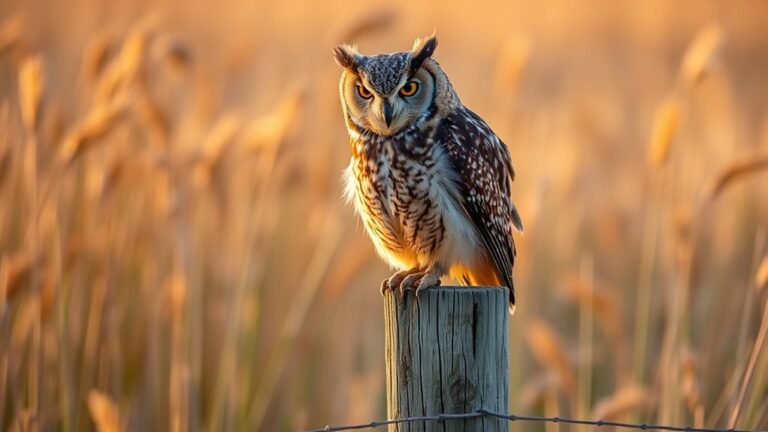Identifying Female Parakeets: Key Features
To identify female parakeets, focus on some key features. First, check the color of their cere, which is the small area above their beak. In adult females, it often turns brown or tan. This color change is a strong sign that the bird is female.
Next, look at their body shape. Female parakeets are usually bulkier than males, giving them a rounder look.
These traits help you tell the difference between male and female parakeets. Keep watching your feathered friends, and you'll get better at spotting these signs! Do you see anything else that might help you identify them?
A Quick Overview
Identifying Female Parakeets: Key Features
- Female parakeets have ceres that are light blue to brown. Adult females usually have brown or tan ceres.
- They are larger and rounder than male parakeets. Males tend to be slimmer and sleeker.
- Female parakeets show caring behaviors. They bond and groom other birds, showing they are social animals.
- During breeding season, females can be assertive. They mark their territory and explore their surroundings.
- When nesting, they like to use soft materials like shredded paper. They also prefer quiet and safe places to lay their eggs.
Understanding Sexual Dimorphism in Parakeets

When you look at parakeets, you can see clear differences between males and females. This is called sexual dimorphism. Male parakeets often have bright colors. These colors help them attract mates.
On the other hand, female parakeets usually have softer, more muted colors. These colors help them blend into their surroundings, especially when nesting.
Hormones play a big part in these differences. In males, testosterone makes their colors brighter. In females, estrogen helps them develop traits that are good for raising young.
Knowing how to tell male and female parakeets apart can make you appreciate these birds even more. It also lets you learn more about their biology and behaviors. This knowledge connects you with a community of people who love birds and want to learn more.
Analyzing the Cere Color
To tell if a parakeet is a girl, you need to look at her cere. The cere is the soft part right above the beak. For female parakeets, the color of the cere usually goes from light blue to brown. This can depend on the species and how old the bird is.
For instance, in budgerigars, adult girls usually have a brown or tan cere. This is a big clue because boys have bright blue ceres.
Young female parakeets can change colors, so it's important to watch closely. Knowing these color differences helps you tell the boys from the girls.
This knowledge makes having a parakeet more fun. It also helps you connect with other parakeet lovers in your community. Enjoy getting to know your feathered friend!
Body Size and Shape Differences

Body size and shape can help you figure out if a parakeet is a boy or a girl. Usually, female parakeets are a bit bigger than male parakeets. This size difference can be a good clue when trying to tell them apart.
Look at their shapes, too. Female parakeets often have rounder bodies, while males look more slim and sleek. You can see this easily if you compare them side by side.
Females usually have a wider and stronger-looking build. This makes them appear sturdier.
Feather Patterns and Colors
Feather patterns and colors help you tell female parakeets apart from males. Female parakeets usually have softer colors. Instead of bright blues or yellows, females show gentle greens or light shades. This makes their beauty more subtle.
Look closely at their heads and throats too. Female parakeets have less noticeable markings there. Paying attention to these details can help you learn more about the gender of your parakeet.
Behavioral Traits Unique to Females

How can you spot the unique behaviors of female parakeets? Watching how they interact with others is a great start.
Female parakeets often show more caring and friendly behaviors. They enjoy bonding with other birds and love to groom them or play together. This shows how social they are.
Hormones also affect their behavior. During breeding season, female parakeets can become more bold. They might act confidently as they mark their space and interact with other birds. This mix of caring and assertive behaviors creates an interesting dynamic.
Vocalizations and Sounds
Understanding the sounds that female parakeets make can help you connect with them better. These lovely birds have their own special ways of chirping that are different from male parakeets.
Listen closely to their sounds. Female parakeets usually make softer, sweeter chirps, especially when they feel safe or want your attention.
You might hear them change the pitch of their calls. This change can show how they feel or if they want to interact with you. When you recognize these sounds, you can better understand what they need. Talking with them through their chirps helps build trust and friendship, making your time together enjoyable.
Observing Nesting Habits
When you watch female parakeets build nests, you can learn a lot about what they need and how they behave.
Here are some key points to think about:
- Nesting Materials: They like to use soft things like shredded paper, grass, or feathers. This makes their nests cozy and safe.
- Location Choices: Female parakeets choose quiet and safe places to lay their eggs. They often pick corners of their cage or hidden spots.
- Behavior During Laying: When it's time to lay eggs, female parakeets may act shy. They often become less active and might make soft sounds.
Watching these behaviors can help you understand how to care for them better and create a good environment for their nesting.
Age Considerations in Identification
Watching how female parakeets build nests gives us important clues about their habits.
But their age is also very important for spotting differences in them. Young parakeets look different from older ones. For example, younger parakeets have soft colors and less clear patterns, which can make it hard to tell them apart. As they grow, their colors become bright and bold.
You can see changes in their cere, which is the fleshy area above their beak. The color of the cere changes as the birds age.
Around six months old, female parakeets start to show more adult features. Knowing these age differences can help you identify them better.
It can also help you connect with these amazing birds on a deeper level. Enjoy learning about your feathered friends!
Tips for Accurate Identification
If you want to tell female parakeets apart from males, look closely at their cere and feathers. With a little practice, you can spot the differences easily.
Here are some simple tips to help you:
- Look at the cere: Adult female parakeets usually have a light brown or beige cere. Male parakeets have bright blue ceres.
- Check their feathers: Female parakeets often have softer, less bright colors than males, especially when they're around others.
- Watch how they preen: Healthy feathers show that a bird is happy. If a female preens her feathers a lot, it might mean she's stressed or uncomfortable.
Using these tips can make it easier to identify your parakeets.
Enjoy watching and learning about them!
Frequently Asked Questions
Can Female Parakeets Live Alone Successfully?
Yes, female parakeets can live alone, but they need some company. Some birds do well on their own, while others can feel lonely. It's important to spend time with them and keep them busy. Play with them, talk to them, and give them toys. This helps them stay happy and healthy.
Do Female Parakeets Require Different Diets Than Males?
Female parakeets do not need a very different diet from male parakeets. However, you should watch their calcium intake. Female parakeets often need extra calcium when they are breeding. This helps keep them healthy and strong. Just make sure to include some good calcium sources in their food while they are in your care.
How Do I Choose a Female Parakeet?
To choose a female parakeet, think about what colors you like. Watch her play and interact with other birds. A friendly and active parakeet will often fit in well at home. She can become a happy companion. Just pay attention to her personality. That way, you can find a great match for you!
Can Female Parakeets Display Male-Typical Behaviors?
Yes, female parakeets can show behaviors that are usually seen in males. They might try to be the boss in their group, perform courtship actions, or copy sounds they hear. These behaviors show that female parakeets can adapt and have their own unique personalities within their flock.
What Are Common Health Issues in Female Parakeets?
Female parakeets can get sick just like any other pet. Some common health problems are respiratory infections and egg binding. If your parakeet seems different, it might be stressed or not getting the right food. Watching their behavior and health is important to keep them happy and healthy. Regular check-ups can also help catch any issues early. Always make sure they have good food, clean water, and a comfy space to live. If you notice anything unusual, talk to a vet who knows birds. They can give you the best advice for caring for your feathered friend.

Luna is the passionate founder and author of Birds and You, a website dedicated to sharing her love for birds with fellow enthusiasts. Through her engaging articles and guides, she aims to educate and inspire others to explore the fascinating world of birds. When she’s not writing, you can find Luna observing birds in their natural habitats or sharing beautiful bird photography on Pinterest. Join her on this journey to celebrate and protect our feathered friends!







